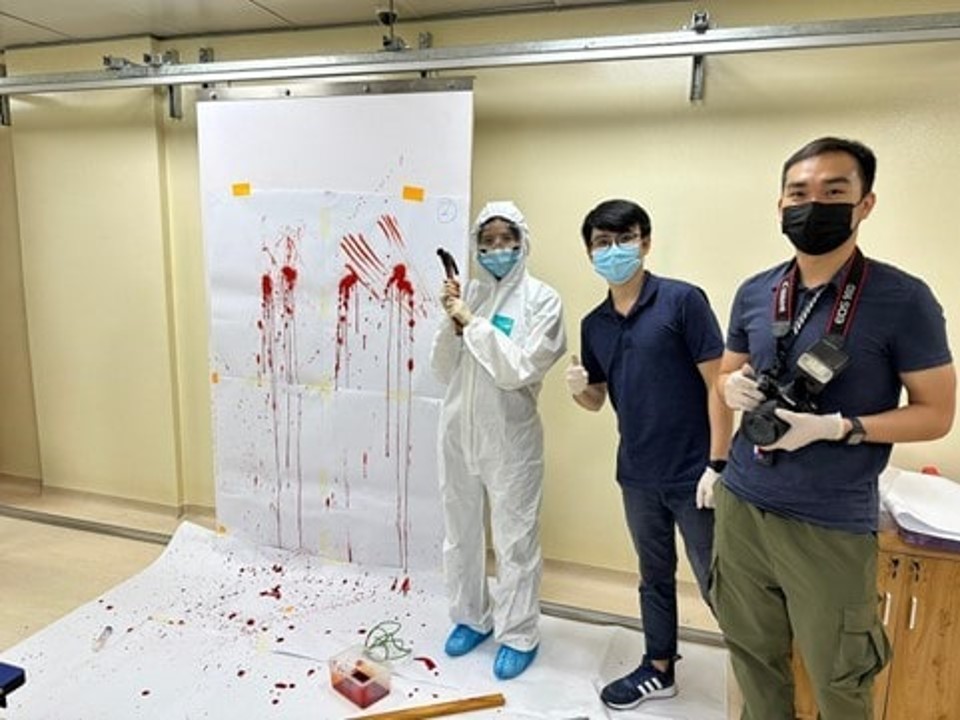 Hands-on Bloodstain Pattern Analysis (BPA) practical session where trainees take turns to create blood patterns and interpret bloodstain patterns created by other teams. (Photo: HTX)
Hands-on Bloodstain Pattern Analysis (BPA) practical session where trainees take turns to create blood patterns and interpret bloodstain patterns created by other teams. (Photo: HTX)
When a crime takes place, it is a race against time to gather evidence within the golden hours. This is when the crime has just been committed and the forensic evidence is freshest.
Upon arrival at a crime scene, crime scene specialists
need to quickly collect samples such as hair, blood, and fibres for analysis. Depending on the facts of the case, DNA swabs may be taken, and fingerprints may be lifted. The crime scene will be photographed, and sketch plans may be drawn to complement
the photographs for investigations. The shape, distribution, and size of bloodstains can also be analysed to shed light on how the crime took place — the list of tasks goes on.
To Senior Crime Scene Specialist Han Seow Chee from HTX’s
Forensics Centre of Expertise (CoE), these seemingly routine tasks still present unique challenges that require her focused attention each time she attends
to a crime scene as there are no two crime scenes that are the same. After examining crime scenes for almost a decade, Seow Chee is unfazed by the macabre sight of blood and gore, as she works swiftly with Singapore Police Force (SPF) Investigation
Officers to secure the forensic evidence needed for the investigation.
Now, she shares her extensive knowledge and experience as one of the trainers teaching in the Crime Scene Specialist Course, which is part of the 12-week milestone course
for entry-level Crime Scene Specialists. This course aims to equip them with essential skills for core forensic work.
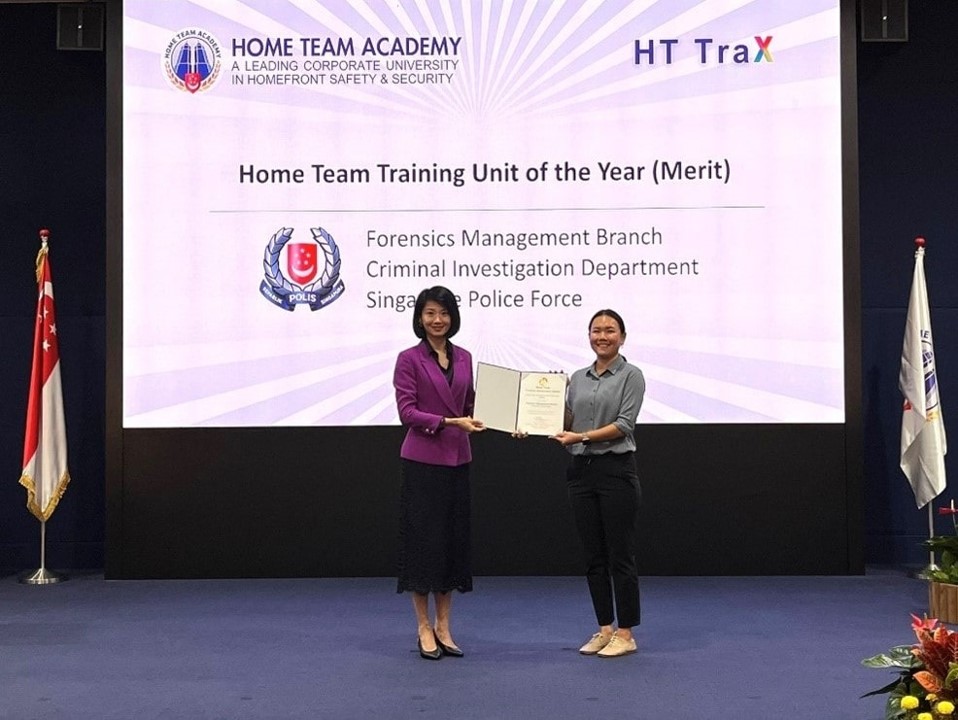 Ms. Han Seow Chee receiving the Home Team Training Unit of the Year (Merit) on behalf of the Forensics Division Training Team at the Home Team Training Excellence Awards (HT TraX) 2023 from Ms. Sun Xue Ling, Minister of State (MHA). (Photo: HTX)
Ms. Han Seow Chee receiving the Home Team Training Unit of the Year (Merit) on behalf of the Forensics Division Training Team at the Home Team Training Excellence Awards (HT TraX) 2023 from Ms. Sun Xue Ling, Minister of State (MHA). (Photo: HTX)
Developed based upon the rigorous job requirements and incorporating extensive personal experience from the trainers, the course earned the Forensics team the SPF Training Team of the Year award in the 2023 SPF Training Award category, as well as the Home Team Training Unit of the Year (Merit) award at the 2023 Home Team Training Excellence Awards. Both awards were a first for the department.
Seow Chee, who leads the 12-member training team, explains that the course will train participants to become full-fledged Crime Scene Specialists. Over the 12 weeks, trainees will be trained in foundational crime scene investigation and evidence management skills, including but not limited to, photography, forensic examination of evidence, and fingerprint search techniques. In addition, trainees will learn to use forensic equipment and other technologies to detect and recover trace evidence efficiently.
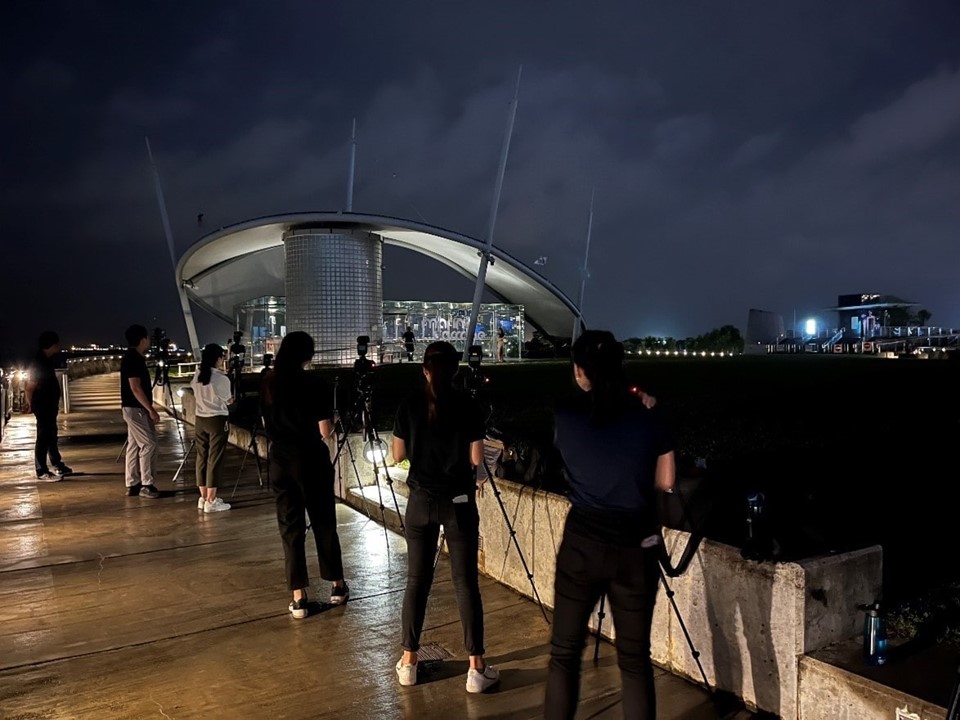 Trainees honing their night photography skills during night photography session at Marina Barrage. (Photo: HTX)
Trainees honing their night photography skills during night photography session at Marina Barrage. (Photo: HTX)
The programme also seeks to develop critical thinking and problem-solving skills in its trainees through its extensive hands-on mock scene curriculum. Trainees will experience scene processing independently as well as in teams. This approach aims to nurture Crimes Scene Specialists who can both excel as independent operators and strong team players.
In today's rapidly changing security landscape, highly skilled and adaptable Crime Scene Specialists provide reliable forensic support to SPF's Investigation Fraternity. Swift and accurate crime scene investigation and analysis can lead to the prompt identification and apprehension of suspects, which is critical in maintaining Singapore’s high level of safety and security.
Seow Chee stressed that: “Each module has specific learning objectives tailored to ensure that officers are capable of meeting the stringent demands of their job upon completing their training.” In addition, significant emphasis has been placed on providing trainees with the opportunities to apply their knowledge.
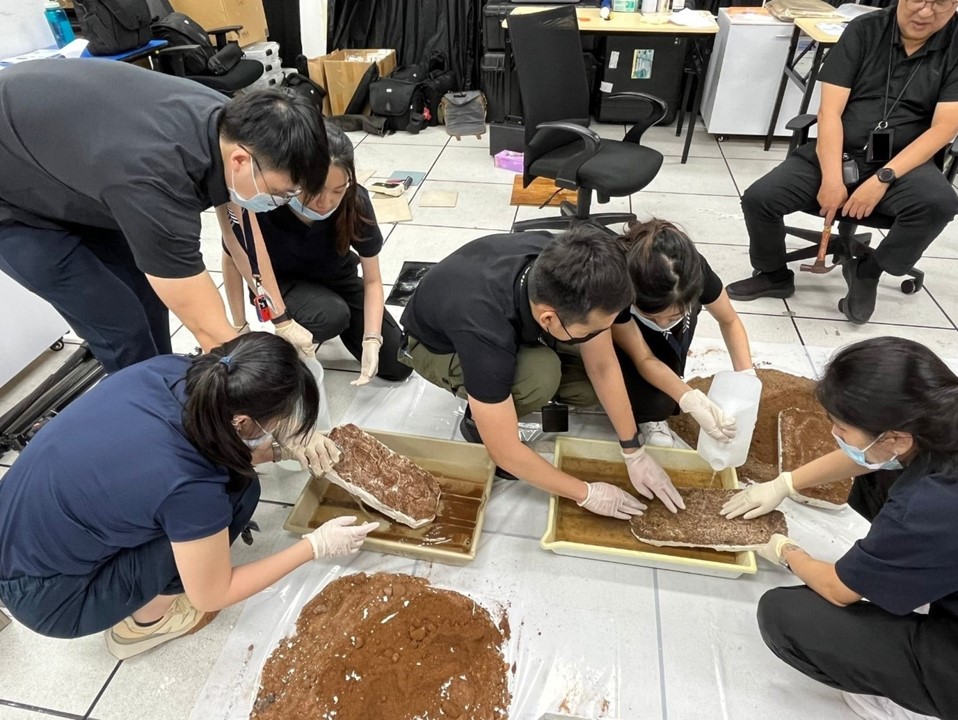 Trainees working hand-in-hand to cast footwear impressions during practical session. (Photo: HTX)
Trainees working hand-in-hand to cast footwear impressions during practical session. (Photo: HTX)
For example, part of the course is delivered using the flipped classroom approach. Trainees are first divided into groups. They are then tasked with researching selected topics and subsequently teaching their fellow trainees about their assigned topics. This independent learning approach aims to challenge trainees to think critically about how their theoretical knowledge can be applied in the real world.
To enhance training realism, trainers make use their practical experience to create realistic mock scenes of various crimes for participants to process. During these sessions, the trainers take on the roles of Investigation Officers, Ground Response Force officers, and members of the public. Creating a diverse range of crime scenes helps the participants develop adaptability and better prepare for the variety of actual crime scenes that they will encounter in the future.
Throughout the programme, there is also strong emphasis on formative assessment and feedback. Trainees receive regular feedback that is specific, actionable, and supportive to help them develop their skills and achieve the learning objectives.
“These are invaluable opportunities for trainees to immerse themselves in real-life situations, without the risks associated with processing actual crime scenes,” Seow Chee shares.
“Through these practices, trainees can enhance their problem-solving skills, critical thinking, and decision-making abilities in a controlled environment.”
The emphasis on practical training have been well-received by the trainees, especially in the area of Bloodstain Pattern Analysis (BPA). BPA requires trainees to make sense of blood spatter patterns at a crime scene, one of which is determining the area of origin of the impact. To achieve this, the traditional BPA method is used. This method involves stringing, where strings are used to trace bloodstains and the area where the strings converge will determine the area of impact.
To better impart BPA skills by leveraging technology, Seow Chee and her team make use of the new Mixed Reality (MR) training system. Developed by HTX’s Human Factors and Simulation CoE in collaboration with Forensics Division, the MR training system allows virtual bloodstains to be projected onto the environment. The trainee can then draw holographic lines to track the angles of impact of the computer-generated bloodstains – enhancing both training realism and efficiency.
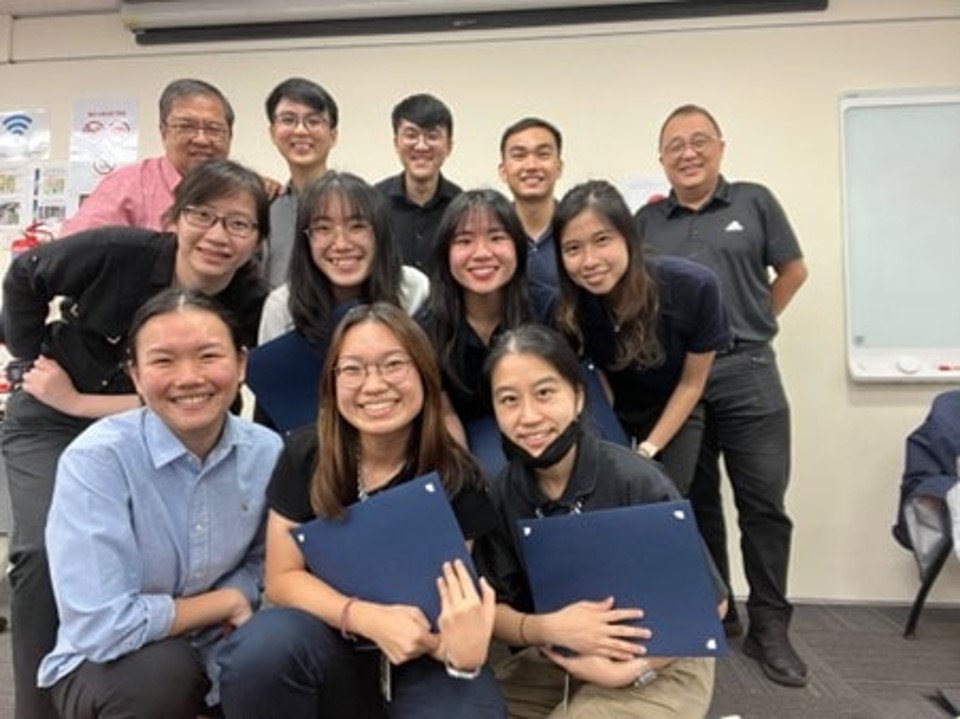 All smiles after their successful completion of Crime Scene Specialist Course (CSSC)! (Photo: HTX)
All smiles after their successful completion of Crime Scene Specialist Course (CSSC)! (Photo: HTX)
Reflecting on her team’s development of the course and their accomplishments in the Home Team Training Excellence Awards and SPF Training Awards, Seow Chee is only motivated to do better in the future.
“In the future, we look forward to collaborating with relevant departments to leverage technology such as Virtual Reality (VR) and Augmented Reality (AR) to develop a wider range of highly realistic and immersive crime scene scenarios for trainees to practice their crime processing skills,” she concludes.
